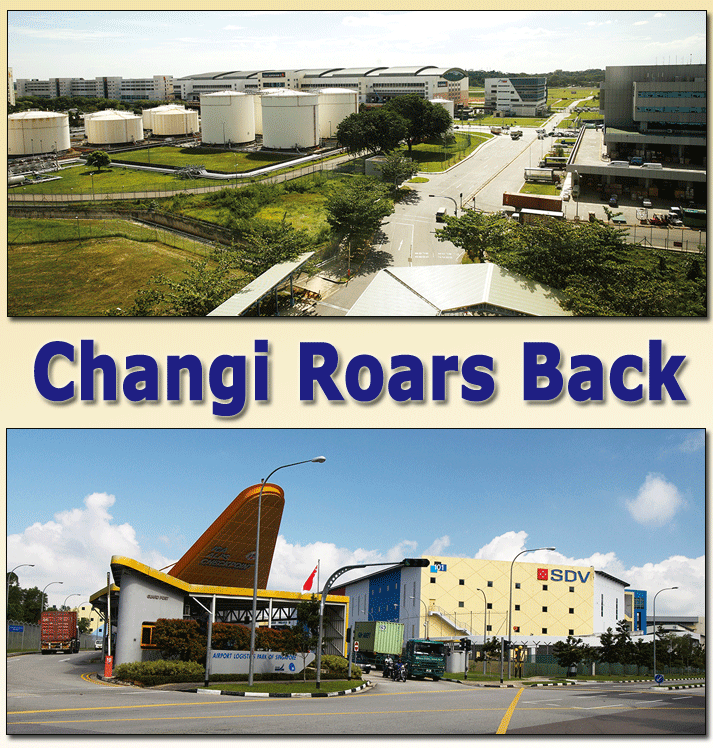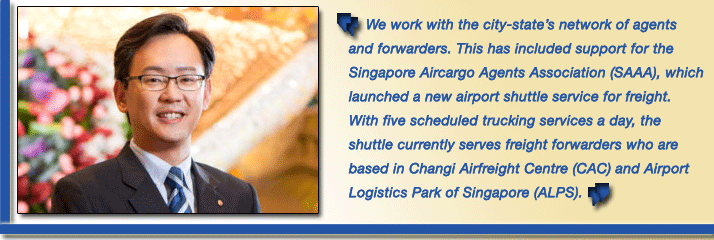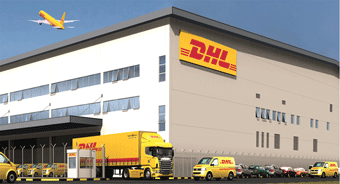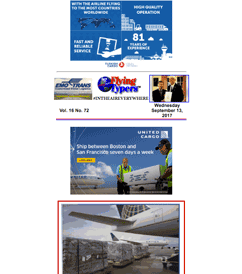 |
After a decade of limited cargo growth,
Singapore’s Changi Airport is undergoing something of a freight
renaissance.
As reported by FlyingTypers earlier
this year, in 2016 the Southeast Asian hub recorded 6.3 percent expansion
in throughput to take annual tonnage to 1.97 million tons. This year Changi
seems certain to finally break the 2 million-ton barrier.
It would be easy to attribute this success
to the overall growth of air freight markets spurred on by positive economic
tailwinds over the last 18 months. But over the decade previous to 2016,
growth across Asian markets barely registered at Singapore. Throughput
remained static even as the region’s other hubs saw steady improvements.
So FlyingTypers asked the amiable
but dynamic Mr. Lim Ching Kiat, Managing Director, Air Hub Development
at Changi Airport Group, what has changed. He believes Changi has upped
its game to win market share in the highly competitive Southeast Asian
air freight market, not least by targeting fast-growing niche trades in
high value products.
 |
For example, he pointed out, Changi was the
first air cargo community in the Asia Pacific region to attain IATA CEIV
Pharma certification, allowing pharmaceutical products to be handled with
the highest standards. A total of 10 companies have now attained certification:
SIA Cargo, dnata Singapore, SATS, Global Airfreight International, Expeditors
Singapore, CEVA Logistics Singapore, Schenker Singapore, Kuehne + Nagel
Singapore, Bollore Logistics Singapore and DHL Global Forwarding.
“To date, we have established an end-to-end
supply chain that meets the IATA CEIV Pharma standards,” said Lim.
“As pharmaceutical shippers and logistics players in Asia Pacific
gain better awareness of the IATA CEIV Pharma certification, we see that
it will gain traction in this region.
“Increasingly, we are seeing more
shippers requesting for their pharmaceutical cargo to be routed via IATA
CEIV Pharma certified hubs and trade lanes.”
On a global level, Changi Airport is also
a strategic member of Pharma.Aero, an organization that gathers like-minded
partners to share market knowledge and improve end-to-end reliability
of pharmaceutical cargo handling. “We are excited to be working
with IATA-CEIV certified partners across the global supply chain to embark
on new initiatives including the Airside Transport Benchmark, CEIV Pharma
shippers’ validation, Certified Pharma lanes & Identification
of Performance Indexes and Dashboard Pharma.Aero Shippers Advisory Group,”
he said.
 Changi
is also shaping up to be a strategic express and e-commerce hub following
the launch of DHL’s Express South-Asia Hub in October 2016 and SATS’
e-Commerce Airhub in April this year, the latter boasting Singapore Post
(SingPost) as its anchor customer. “The new facility has improved
efficiency and space utilization, and enhanced the consignment handling
capabilities for both SATS and SingPost,” explained Lim. Changi
is also shaping up to be a strategic express and e-commerce hub following
the launch of DHL’s Express South-Asia Hub in October 2016 and SATS’
e-Commerce Airhub in April this year, the latter boasting Singapore Post
(SingPost) as its anchor customer. “The new facility has improved
efficiency and space utilization, and enhanced the consignment handling
capabilities for both SATS and SingPost,” explained Lim.
“SATS is the first ground handler
in the region to own such an airside facility. With mailbag processing
capability increasing by more than three times and automation to reduce
mail processing time by 50% in this new facility, e-commerce shipments
can be loaded more quickly onto flights.
“This development has augmented Singapore’s
value proposition as a regional e-commerce hub.”
Changi’s managers have also been supporting
the city-state’s network of agents and forwarders as they attempt
to compete against cheaper regionals hubs where labor and land are usually
less expensive than in prosperous Singapore. This has included support
for the Singapore Aircargo Agents Association (SAAA) which launched a
new airport shuttle service for freight in August last year, as documented
by FlyingTypers.
“Air Cargo Terminal Shuttle (CT) was
introduced to facilitate freight forwarders’ lodge-in of export
shipments to ground handlers’ facilities, improve asset utilization
of trucks and address congestions and long idle times at ground handling
terminals during peak periods,” explained Lim.
“With five scheduled trucking services
a day, the shuttle currently serves freight forwarders which are based
in Changi Airfreight Centre (CAC) and Airport Logistics Park of Singapore
(ALPS).
“ACTS aims to optimize the outbound
supply chain processes by streamlining the delivery of loose export cargo
from individual freight forwarders’ premises to the ground handlers
on priority lanes.
“More recently, SAAA works with the
Cargo Community Network (CCN) to house the online booking portal via an
LINC platform to facilitate ease of booking and access to schedule and
status information. Drivers are also equipped
with mobile applications to perform real-time update on the shipment status.”
Lim said CAG tries to support the entire
air cargo community including airlines, ground handlers and freight forwarders
as it bids to further expand cargo volume and deepen Changi’s network.
In 2017 the strategy is seeing further success. Cargo movements across
all flows – imports, exports and transshipments - grew 6.8% year-on-year
which led to volumes handled in the first half of 2017 totaling 1.02 million
tons.
“This could be attributed but not
restricted to the improvement in global economic climate, shippers’
enhanced confidence in our air cargo handling capabilities and injection
of freight capacity,” said Lim. “In particular, our cargo
performance with major markets such as China (+17%), USA (+12%) and Germany
(+27%) all saw strong growth for the first half of the year.
“China posted robust growth in pharmaceutical,
electrical and mechanical equipment manufacturing sectors with export
orders in June rising to the highest level in five years. Production continues
to grow in the US, while Germany’s manufacturing growth has also
reached a six-year high.”
He said that with IATA forecasting cargo
demand to grow by 7.5% in 2017 and with 90% of the respondents to its
latest confidence survey expecting a further increase or no change to
freight volumes over the next 12 months, the outlook was bright.
“In Singapore, the Singapore Economic
Development Board has recently reported that a majority of firms in the
manufacturing sector expect the key manufacturing clusters to continue
the growth in the second half of the year with biomedical and precision
engineering clusters having the most optimistic outlook,” added
Lim.
“Given all this, we are hopeful that
the growth trend continues into the second half of 2017, even though we
remain cautious about the uncertainties in the global political and economic
environment.”
SkyKing |




 Vol.
16 No. 72
Vol.
16 No. 72